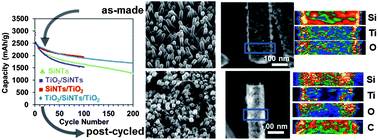The battery is one of the biggest obstacles that is limiting many energy related breakthroughs. From allowing the capture and storage of renewable energy that will accommodate the fluctuating needs of power usage, to the use of electric cars that are able to drive further without needing to be recharged. Many solutions are being sort, some of them seeming increasingly wacky, such as the use of rhubarb to make flow batteries being carried out by Harvard researchers.
Yet it is the much more traditional low-cost lithium-ion batteries that are the most popular. These batteries are already included in a range of commercially available electric cars and small electronic gadgets. The specific energy storage capacity and the charge/discharge rate of Li-ion batteries is critical for their use and increasing this life time remains a significant challenge for their further development.
One method for the improvement is to use silicon based hollow nanostructures as high energy density anodes in these batteries. Using Si as the anode material can considerably increase the energy storage capacity of the battery; however commercialisation remains limited due to the materials accelerated mechanical failure relative to conventional anode materials. This paper by Lotfabad et al, uses atomic layer desorption of TiO2, TiN and Al2O3 on to the inner, outer or both surfaces of hollow Si nanotubes in order to overcome this mechanical failure and enhance the cycling performance of the material. Their results show that by coating with TiO2 both inside and out of the nanotube the coulombic efficiency is as high as 99.9% (among the highest ever reported for this group of materials). In reality this could mean a battery lifetime of up to 1000 cycles. The results presented in this paper are extremely promising for the future of Li-ion batteries.
Si nanotubes ALD coated with TiO2, TiN or AL2O3 as high performance lithium ion battery anodes
Elmira Memarzadeh Lotfabad, Peter Kalisvaart, Alireza Kohandehghan, Kai Cui, Martin Kupsta, Behdokht Farbod and David Mitlin,
J. Mater. Chem. A, 2014, 2, 2504-2516. c3ta14302c
H. L. Parker is a guest web writer for the Journal of Materials Chemistry blog. She currently works at the Green Chemistry Centre of Excellence, the University of York.
To keep up-to-date with all the latest research, sign-up to our RSS feed or Table of contents alert.











